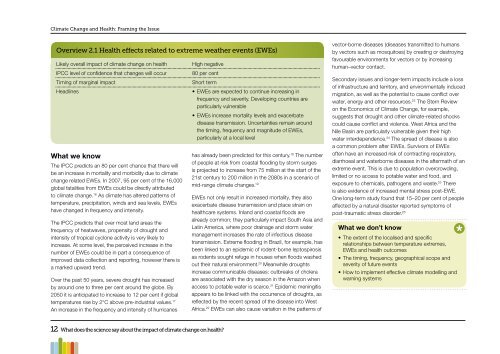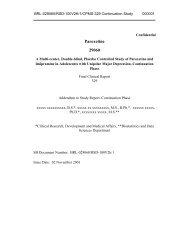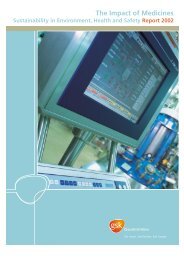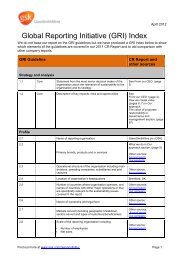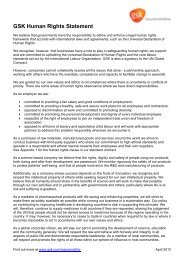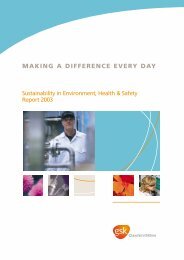Climate Change and Health: Framing the issue
Climate Change and Health: Framing the issue
Climate Change and Health: Framing the issue
Create successful ePaper yourself
Turn your PDF publications into a flip-book with our unique Google optimized e-Paper software.
<strong>Climate</strong> <strong>Change</strong> <strong>and</strong> <strong>Health</strong> <strong>Health</strong>: <strong>Framing</strong> Paper <strong>the</strong> Issue<br />
Overview 2.1 <strong>Health</strong> effects related to extreme wea<strong>the</strong>r events (EWEs)<br />
Likely overall impact of climate change on health High negative<br />
IPCC level of confidence that changes will occur 80 per cent<br />
Timing of marginal impact Short term<br />
Headlines • EWEs are expected to continue increasing in<br />
frequency <strong>and</strong> severity. Developing countries are<br />
particularly vulnerable<br />
• EWEs increase mortality levels <strong>and</strong> exacerbate<br />
disease transmission. Uncertainties remain around<br />
<strong>the</strong> timing, frequency <strong>and</strong> magnitude of EWEs,<br />
particularly at a local level<br />
What we know<br />
The IPCC predicts an 80 per cent chance that <strong>the</strong>re will<br />
be an increase in mortality <strong>and</strong> morbidity due to climate<br />
change related EWEs. In 2007, 95 per cent of <strong>the</strong> 16,000<br />
global fatalities from EWEs could be directly attributed<br />
to climate change. 16 As climate has altered patterns of<br />
temperature, precipitation, winds <strong>and</strong> sea levels, EWEs<br />
have changed in frequency <strong>and</strong> intensity.<br />
The IPCC predicts that over most l<strong>and</strong> areas <strong>the</strong><br />
frequency of heatwaves, propensity of drought <strong>and</strong><br />
intensity of tropical cyclone activity is very likely to<br />
increase. At some level, <strong>the</strong> perceived increase in <strong>the</strong><br />
number of EWEs could be in part a consequence of<br />
improved data collection <strong>and</strong> reporting, however <strong>the</strong>re is<br />
a marked upward trend.<br />
Over <strong>the</strong> past 50 years, severe drought has increased<br />
by around one to three per cent around <strong>the</strong> globe. By<br />
2050 it is anticipated to increase to 12 per cent if global<br />
temperatures rise by 2°C above pre-industrial values. 17<br />
An increase in <strong>the</strong> frequency <strong>and</strong> intensity of hurricanes<br />
012Introduction<br />
12 What does <strong>the</strong> science say about <strong>the</strong> impact of climate change on health?<br />
has already been predicted for this century. 18 The number<br />
of people at risk from coastal flooding by storm surges<br />
is projected to increase from 75 million at <strong>the</strong> start of <strong>the</strong><br />
21st century to 200 million in <strong>the</strong> 2080s in a scenario of<br />
mid-range climate changes. 19<br />
EWEs not only result in increased mortality, <strong>the</strong>y also<br />
exacerbate disease transmission <strong>and</strong> place strain on<br />
healthcare systems. Inl<strong>and</strong> <strong>and</strong> coastal floods are<br />
already common; <strong>the</strong>y particularly impact South Asia <strong>and</strong><br />
Latin America, where poor drainage <strong>and</strong> storm water<br />
management increases <strong>the</strong> rate of infectious disease<br />
transmission. Extreme flooding in Brazil, for example, has<br />
been linked to an epidemic of rodent-borne leptospirosis<br />
as rodents sought refuge in houses when floods washed<br />
out <strong>the</strong>ir natural environment. 20 Meanwhile droughts<br />
increase communicable diseases: outbreaks of cholera<br />
are associated with <strong>the</strong> dry season in <strong>the</strong> Amazon when<br />
access to potable water is scarce. 21 Epidemic meningitis<br />
appears to be linked with <strong>the</strong> occurrence of droughts, as<br />
reflected by <strong>the</strong> recent spread of <strong>the</strong> disease into West<br />
Africa. 22 EWEs can also cause variation in <strong>the</strong> patterns of<br />
vector-borne diseases (diseases transmitted to humans<br />
by vectors such as mosquitoes) by creating or destroying<br />
favourable environments for vectors or by increasing<br />
human–vector contact.<br />
Secondary <strong>issue</strong>s <strong>and</strong> longer-term impacts include a loss<br />
of infrastructure <strong>and</strong> territory, <strong>and</strong> environmentally induced<br />
migration, as well as <strong>the</strong> potential to cause conflict over<br />
water, energy <strong>and</strong> o<strong>the</strong>r resources. 23 The Stern Review<br />
on <strong>the</strong> Economics of <strong>Climate</strong> <strong>Change</strong>, for example,<br />
suggests that drought <strong>and</strong> o<strong>the</strong>r climate-related shocks<br />
could cause conflict <strong>and</strong> violence. West Africa <strong>and</strong> <strong>the</strong><br />
Nile Basin are particularly vulnerable given <strong>the</strong>ir high<br />
water interdependence. 24 The spread of disease is also<br />
a common problem after EWEs. Survivors of EWEs<br />
often have an increased risk of contracting respiratory,<br />
diarrhoeal <strong>and</strong> waterborne diseases in <strong>the</strong> aftermath of an<br />
extreme event. This is due to population overcrowding,<br />
limited or no access to potable water <strong>and</strong> food, <strong>and</strong><br />
exposure to chemicals, pathogens <strong>and</strong> waste. 25 There<br />
is also evidence of increased mental stress post-EWE.<br />
One long-term study found that 15–20 per cent of people<br />
affected by a natural disaster reported symptoms of<br />
post-traumatic stress disorder. 26<br />
What we don’t know<br />
• The extent of <strong>the</strong> localised <strong>and</strong> specific<br />
relationships between temperature extremes,<br />
EWEs <strong>and</strong> health outcomes<br />
• The timing, frequency, geographical scope <strong>and</strong><br />
severity of future events<br />
• How to implement effective climate modelling <strong>and</strong><br />
warning systems<br />
*


